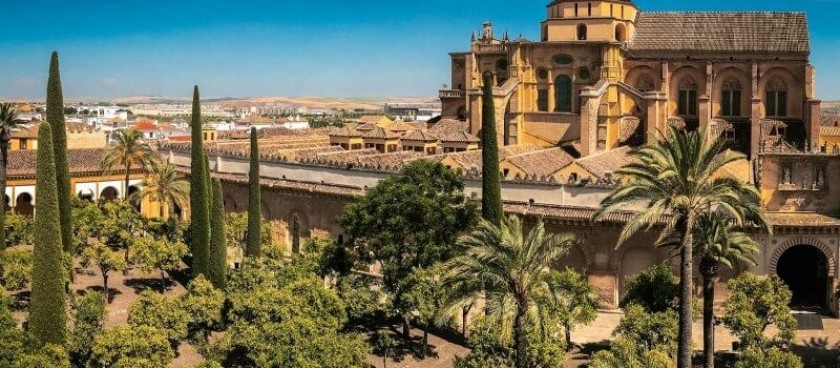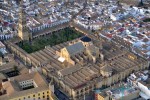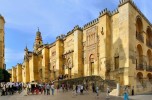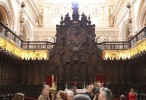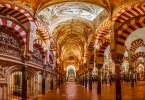- #ES77
- Calle Cardenal Herrero, 1, 14003 Córdoba, Spain
- +34957470512
- informacion@mezquita-catedraldecordoba.es
- https://mezquita-catedraldecordoba.es/
- 37.8789059, -4.7793881 Copy to clipboard Copy
-
#Churches
Mesquita is a cathedral mosque built in Cordoba in 784. During the Middle Ages, it was the second-largest Muslim mosque in the world. Now it is considered the most famous architectural structure in Spain, erected during the reign of the Umayyad dynasty. At the moment, the building included in the TOP-4 of the largest mosques in Europe.
Mesquita is known primarily as one of the most beautiful and oldest in Europe. The interior decoration is striking in its beauty and wealth:
- Golden prayer niches
- High double arches of black onyx and jasper inside the mosque
- A majestic blue dome with pale stars in the centre of Mesquita
The attraction located close to the Cordoba Central train station and the synagogue, on the banks of the Guadalquivir River.
Historical reference
The history of the Mesquita in Cordoba (Spain) is quite long and confusing. So, its construction began in 600, and initially, it mentioned in the annals as the Church of Vincent of Saragossa. Later converted into a mosque, and in the early 710s, the building destroyed.
In 784, a new Muslim mosque erected on the same site - the author of the project was Emir Abd ar-Rahman I, who wanted to immortalize, thus, the name of his wife in history. For 300 years, the building has constantly reconstructed, and new decorative elements have added. The large internal arches made of onyx, jasper and granite attracted a lot of attention, which remain the hallmark of today's attraction.
After the end of the Reconquista in Spain (the struggle of Christians and Muslims for the lands of the Iberian Peninsula), the Mesquita mosque transformed into a church, and until the end of the 18th century, the temple regularly supplemented and decorated with new details. Now it is a functioning Roman Catholic church.
Mosque architecture
Contrary to popular belief, Mesquita is not just a mosque but a huge complex on the territory of chapels built in different historical eras, a large orange garden and other attractions.
The mosque itself in Cordoba built of yellow sandstone, and the window openings and entrance doors decorated with ornate oriental patterns. Initially, Mesquita built in the Moorish style, and however, due to the numerous extensions and reconstructions, it is rather problematic to determine its current architectural style. We can only say that it is a mixture of Moorish, Gothic and Moroccan styles.
Territory
Please pay attention to the chapel of Villaviciosa, which was built already under the Catholic faith, and to the Royal Chapel, in which several European monarchs previously buried (it is now closed to the public).
The Orange Courtyard is the most beautiful place on the complex territory, where palm trees, trees with citrus fruits and exotic flowers grow.
The tower that rises above the temple complex is a former minaret, which became an ordinary observation tower with the advent of Christianity to these lands. It is interesting that now a sculpture of the city's patron saint, the Archangel Raphael, is installed on its top.
Interior decoration
Tourists are enthusiastic about the interior decoration of the Cathedral Mosque in Cordoba. Many say that only here you can see how Muslim patterns are unusually combined with Catholic statues and the altar.
Interestingly, you can read about the beauty of Mesquita not only in modern travel guides to Spain but also in the collection of poems of the famous German poet Heinrich Heine "Almanzor" and the travel notes of the Russian traveller Botkin. Several works by the American artist Edwin Lord Weeks also dedicated to the mosque.
The following objects are most often distinguished:
Column hall. It is the most famous room in the mosque and the most "Muslim" one. In this part of the mosque, there are about 50 arches painted in white and red colours (which is typical for the Moorish style). Once in this part of the Umayyad Mosque in Cordoba, it isn't easy to believe that you are in a temple and not in the emir's palace.
An equally important part of the temple is Mirhab. It is a large gilded room with a niche in the wall, phrases from the Koran written. For Christians, it will be exciting from an architectural point of view.
Cathedral of Cordoba. We can say that Mesquita is a building within a building because right in the centre of the mosque, there is a Catholic church in the Gothic style. The carved mahogany choirs and stone statues are worth noticing.
Catholic mahogany choirs. It is one of the oldest and most skilful parts of the church, which appeared in 1742—each part of the choir decorated with carvings that correspond to a specific historical era or person. Thanks to high-quality materials and the talent of the master, this fantastic work of art have not changed, although it is almost 300 years old.
Catholic Cathedral in Mesquite
The retablo or altar is the central part of any church—Main the main altar in 1618 from rare Kabra marble.
Treasury
The Treasury is the most exciting room of the great mosque in Cordoba, which contains several exciting and precious exhibits: gold cups, silver bowls, personal belongings of bishops and rare rocks. The unique museum items:
Reliefs from the facade of the mosque and pillars of the 6-7 centuries.
Icons of the Marquis de Comares Rodrigo de Leon. These are not separate images of saints but an integral work of art made in a palace and inlaid with precious stones.
Painting "Saint Eulogius Vicente" by Vincenzo Carducci. The canvas depicts the Martyr Saint Eulogius of Cordoba, who looks at the angel in surprise.
Sculpture "Saint Raphael" Sculpture "Saint Raphael"
The sculpture "Saint Raphael" is one of the six masterpieces by Damian de Castro. Creating this piece is unique - first, the master carves a statue from a single piece of wood and then covers it with silver and gold using special plates.
Altarpiece of Our Lady of the Rosary Antonio del Castillo. It is an altarpiece consisting of four paintings by Antonio del Castillo. The Mother of God of the Rosary sits above it, on the sides are the intercessors of Saint Sebastian and Saint Roch, and the crucifix completes the composition.
Painting "Saint Michael" by Juan Pompeo.
Sculpture "Saint Sebastian". It is a graceful sculptural composition consisting of a young man, similar to Apollo, and an angel. The product cast from silver.
The most valuable exhibit is the Tabernacle vessel, cast in 1514, which still used in divine services.
